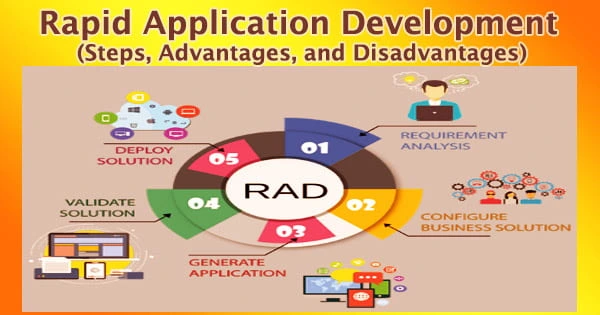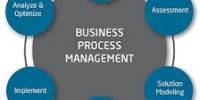Rapid application development (RAD), sometimes known as rapid application building (RAB), is a development strategy that favors speedy prototyping and feedback over lengthy development and testing cycles. The components or functions of the RAD paradigm are developed in concurrently as if they were micro-projects. The projects are timed, delivered, and then put together into a working prototype.
In general, RAD methods to software development place a greater focus on adaptability than on planning. It’s a collaborative technique that relies on prototype and iterative development rather than formal preparation. Prototypes are frequently used in conjunction with, or even in place of, design specifications.
Rapid application development allows developers to make several iterations and modifications to the software without having to restart the development process from the beginning each time. RAD is particularly well suited to (but not limited to) producing software with user interface needs.
The basic goal of RAD is to reduce development time and costs by involving users in all phases of the process. It is a development model that arose from the realization that the classic waterfall style of development was ineffective. Rapid Application Development (or RAD) allows developers to swiftly update software and add several iterations without having to start over.

Consider James Martin’s 1991 invention, the rapid application development model. The RAD technique is still popular among those looking for Agile ways of application development to keep the software development life cycle in step with expanding company and client needs, despite the fact that it has been around for a while.
It’s a continuous evolution of development philosophies in response to the needs of the moment. The spiral model was designed by Barry Boehm and was the first RAD alternative. Boehm and subsequent RAD techniques stressed prototyping in addition to (or instead of) strict design criteria.
Steps in Rapid Application Development –
The rapid prototype release and iteration approach is a type of agile software development technique that emphasizes quick prototype releases and iterations. Although RAD has evolved throughout time, these four fundamental steps have remained consistent.
- Define the Requirements: Rapid application development distinguishes itself from typical software development techniques right away. It doesn’t ask for a lengthy list of specifications from end-users; instead, it asks for a broad request. The broad breadth of the criteria makes it easier to provide particular requirements at various stages of the development process.
- Prototype: This is where all of the action takes place. Rather of adhering to a specific set of criteria, developers produce prototypes with a variety of features and functions as quickly as possible. The clients are then given the prototypes and asked to determine what they like and don’t like. Most of the time, these prototypes are rushed to work in order to demonstrate specific characteristics without adequate polish. This is typical, and the final product is only developed when both the client and the developer agree on the final result during the finalization step.
- Receive Feedback: Prototypes and beta systems are turned into working models at this level. Developers then use customer feedback to alter and improve prototypes in order to build the best product possible.
- Finalize Software: The client finalizes the software’s features, functionalities, aesthetics, and interface here. Prior to providing to the client, stability, usability, and maintainability are critical.
Advantages and Disadvantages of Rapid Application Development –
Unlike the Waterfall method, the RAD model prioritizes software and user feedback over meticulous planning and requirements documentation. During the pinnacle of interest in business re-engineering, the RAD technique also matured.
Some of the key advantages of RAD include:
- The program will be more useable, and it will have a higher chance of focusing on business challenges that are important to end users rather than technical issues that engineers are interested in.
- Iterative development reduces development time and accelerates delivery. Code reuse is encouraged, which implies less manual coding, fewer errors, and faster testing times.
- Although much of the literature on RAD focuses on speed and user interaction, risk mitigation is an important aspect of RAD done well. A RAD strategy can zero in on critical risk variables early on and make adjustments based on empirical evidence gathered throughout the early stages of the process. Consider the difficulty of prototyping some of the system’s most sophisticated components.
- Due to high-level collaboration and coordination across stakeholders, RAD boosted customer satisfaction (developers, clients, and end users).
- RAD includes minimal documentation and automated tools, making it a simple and quick way to create prototypes.
- Better risk management since stakeholders may talk about and fix code flaws while development is still going on. Generator Spreadsheets and domain-specific languages have been used by RAD.
- Increasing the number of projects completed on schedule and on budget. Fewer surprises, as RAD involves integrations early in the software development process, unlike the Waterfall method.
The purported disadvantages of RAD include:
- RAD was a novel method for most IT shops, requiring seasoned employees to rethink how they operated. Humans are notoriously resistant to change, therefore any project including new tools or procedures is more likely to fail the first time around simply owing to the need for the team to learn.
- Because the cost of code production is so high, it’s not a good fit for low-margin applications.
- The only system that can be constructed with RAD is one that can be modularised. Non-functional needs are typically not visible to the end-user in regular operation, hence there is a lack of emphasis on them.
- One thing that almost all RAD techniques have in common is that there is significantly more contact between users and developers across the entire life cycle.
- Because all of the requirements must be known before the project begins, the model is inflexible. Flexibility and control are inextricably linked; having more of one means having less of the other. If a project (for example, life-critical software) values control over agility, RAD is not the right choice.
- The stages of RAD are poorly defined and unstructured. In certain circumstances, the emphasis on prototypes might go too far, leading to a “hack and test” process in which developers make tiny changes to individual components while neglecting system architecture issues that could lead to a better overall design.
- Small to medium-sized project teams are often the focus of RAD. When implementing a RAD technique for very large-scale systems, the additional limitations mentioned above (less design and control) bring unique challenges.
If there is a high availability of designers for modeling and the budget is large enough to cover their costs as well as the expense of automated code generation technologies, RAD should be implemented. Rapid application development differs from other software development models by a significant amount.
Obviously, the most significant difference is how rapid application development prioritizes speed above other approaches, which often prioritize delivering a working product to the client. This software company adopted the RAD approach, which allowed for easy customer interaction. They immediately grasped their client’s demands and requirements using the RAD model.
Information Sources:
















